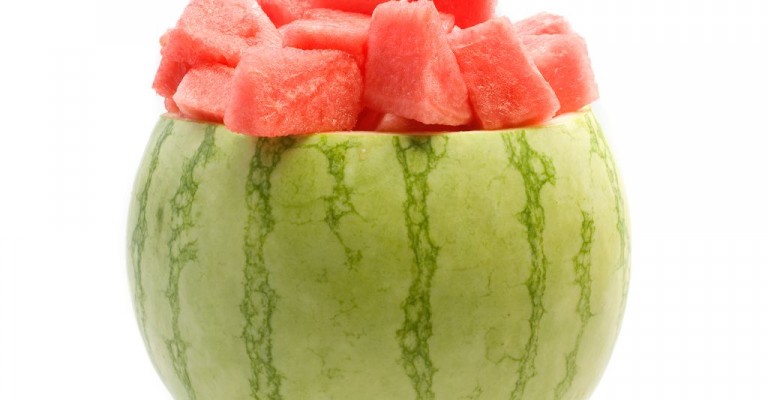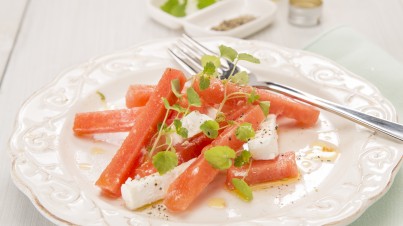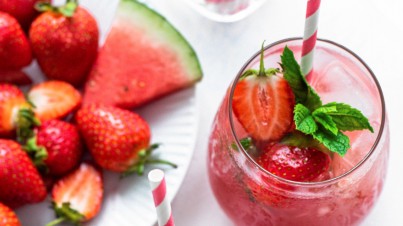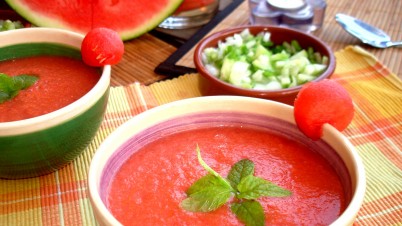The refreshing taste of summer in many countries, watermelon is an enduring joy.
How to prepare
Cut it up and dig in!
Chopping up a whole melon can be a bit intimidating - here are some tips:
You’ll need:
A long, sharp knife.
A big chopping board. Even better if it has draining grooves.
Cubed:
1. Slice the watermelon in half, so you have 2 pieces with round, circular-cut sides.
2. Trim the rind off the stem and blossom end.
3. Put the melon face-down on the chopping board, so the larger cut side is flat on the board.
4. Starting at the top/stem end, hold your knife at an angle to cut down towards the chopping board; removing strips of rind. The same way you might for an orange.
5. Once your rind is off, cut the melon horizontally into thirds, then vertically into cubes.
6. Repeat for the second half and eat it up or store it in the fridge.
Wedges:
1. Trim the rind off the stem and blossom ends.
2. Slice the watermelon in half lengthwise, so you have 2 pieces with large oval cut sides.
3. Place one side on the chopping board, cut side down.
4. Slice it crosswise, into roughly 1-inch wedges, and repeat.
Serve up and enjoy!
Buyer's and storage guide
There's nothing worse than carting home a heavy watermelon to find tasteless, tepid disappointment. It makes even an avid watermelon enthusiast hesitant at the greengrocer! So how do you choose a good watermelon?
Watermelon doesn’t continue to ripen after harvesting, so you have to try and choose a ripe one. These tips will help you choose a joyful, ripe bundle of sweetness.
Ground Spot
Yellow not white and it will taste alright! The underside of the watermelon should be buttery yellow. This is the field patch or ground spot, where it touched the ground while growing. A white spot indicates the melon was harvested too early.
Shape
Melons come in different shapes and sizes - round, oval, and elongated, depending on the variety. Keep an eye out for a melon with a uniform shape. Weird bulges or distorted shapes indicate a lower-quality fruit.
Weight
Pick it up! Weigh your choices and opt for the heavier melon. A ripe watermelon should feel weighty in your hands, no matter its size. Bigger is not always better.
Skin
Look for sugar scars. Brown spots and marks or raised, dirt-like webbing on a watermelon is a good sign! These are scars from pollination and mean a sweeter melon. If you see black, hard spots – don’t shy away. This is sugar, not rot.
Sound
The bongo method. The jury is out on this one. Some people say that rapping on a ripe melon will give a resonant, satisfying hollow sound. If the thump is dull sounding, pass on it. We’re not sure if this is reliable, but it is fun!
Squeeze
Press your thumbs into the blossom end (opposite to the stem end) to see how much ‘give’ it has. Go for the Goldilocks method.
Under ripe: it will be hard as a rock and you won’t be able to press it in.
Overripe: it will give no resistance, and might have that grainy mushy texture once you chop it open.
Ripe: Just right! Somewhere between, a little give but not too much.
Storing
A whole watermelon might keep at room temperature for a week or two. There's no need to let a whole melon - perfect and daunting - sit in the bottom of the fridge for too long. It won’t get any riper waiting for you to slice it up. Once it’s chopped, it will last in the fridge in an airtight container for around 3 days.
If you’re going to eat it as a fresh snack, cut half (or all) of it up and pop it in the fridge once you lug it home. If it’s chopped and ready to snack on, it’s much less likely to go to waste and will take up less space in your fridge.
You can freeze watermelon! It will be mushy once it thaws, but it's perfect for blending. If you’re a fan of watermelon in smoothies and margaritas - it’s a great way to save leftover melon from going to waste.
Nutrition
Watermelon fruit is 91% water, contains 6% sugars, and is low in fat.
In a 100 gram (3.5 ounce) serving, watermelon fruit supplies 125 kilojoules (30 kilocalories) of food energy and low amounts of essential nutrients. (source https://fdc.nal.usda.gov)
About the plant
Watermelon (Citrullus lanatus) is a flowering plant species of the Cucurbitaceae family; the same family as cucumbers, zucchini/courgette and other gourds. It's a climbing vine-like plant, cultivated worldwide for its sweet fruit. To add a little confusion, watermelon is not a melon! Melons have a central seed cavity, whereas watermelons have seeds dispersed through the flesh.
Watermelon vines are thin, grooved and woolly - covered in tiny hairs. The leaves are wonderfully lobed, almost like a fig.
The fruit can range in weight from less than 1 kg (2.25 lb) to more than 90 kg (200 lb), and the flesh can be red, pink, orange, yellow or white.
History
Watermelon has a rich and interesting history - people have been enjoying watermelon for millennia. Watermelon seeds were found, alongside other fruit remnants, at a 5,000-year-old settlement in Libya -but it was not always the sweet, pink snack it is today.
Early watermelons were bitter, with yellowish-white flesh, prized for their ability to store water. They provide a crucial water source to many, including the indigenous people of the Kalahari Desert.
This predecessor of the modern watermelon was cultivated in Africa before spreading north into Mediterranean countries and, later, to other parts of Europe.
Watermelons were also celebrated in ancient Egypt. Seeds and paintings of watermelons were uncovered in ancient tombs, including the lavish tomb of Pharaoh Tutankhamun. By 2000 BC watermelons were domesticated in Egypt.
While initially cultivated as a source of water, through the process of cultivation and selective breeding, watermelons became sweeter, easier to open, and more disease resistant. They spread across the Mediterranean world during Roman times.
Physicians, including Hippocrates and Dioscorides, praised its many healing properties.
The first colour sketches of a red-fleshed, sweet watermelon in Europe were found in a medieval manuscript, the Tacuinum Sanitatis. This was a guide to healthy living based on the 11th-century Arabic manuscript.
Today, there are more than 1,200 cultivars of watermelon. (A cultivar is a plant variety that has been produced in cultivation by selective breeding).
Sources:
Bot, A, 2015, Origin and emergence of the sweet dessert watermelon, Citrullus lanatus, Address: https://www.ncbi.nlm.nih.gov/pmc/articles/PMC4512189/, (Accessed 26/07/2023)
Strauss, M. (2015) The 5,000-Year Secret History of the Watermelon, Address, https://www.nationalgeographic.com/history/article/150821-watermelon-fruit-history-agriculture, (accessed 26/07/23)
Washington State University (WSU) Northwestern Washington Research and Extension Center (NWREC), 2017, Icebox Watermelons, Address: http://agsyst.wsu.edu/Watermelon.html (accessed 26/07/2023)Guinness World Records, 2013, Heaviest Watermelon, Address: https://www.guinnessworldrecords.com/world-records/heaviest-watermelon, (accessed 26/07/2023)EVS Translations, 2016, Watermelon, Address: https://evs-translations.com/blog/watermelon/, (Accessed 26/07/2023)
Serving
- In a fruit salad
- Serve with a few leaves of mint
- Make a salad with goat or feta cheese and mint as garnish
- Make homemade watermelon sorbet



